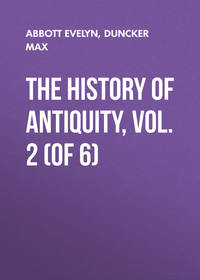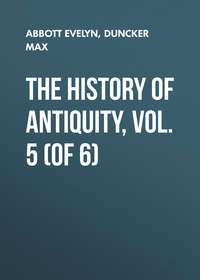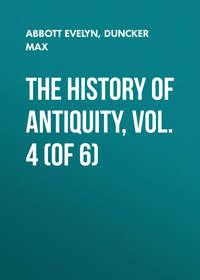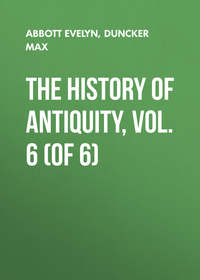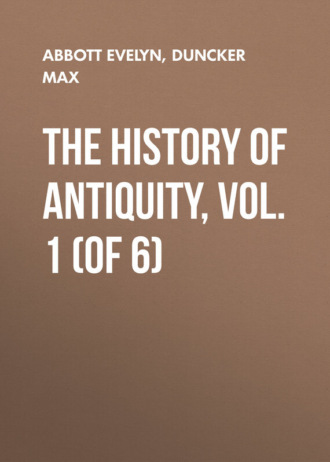 полная версия
полная версияThe History of Antiquity, Vol. 1 (of 6)
The identification of Neith with Athene (Herod. 2, 62; Plat. "Tim." p. 21) rests on the similarity of the name, on the torch-races in honour of Pallas at Athens, and the feast of lamps at Sais. Gutschmid, "Beiträge zur Geschichte des alten Orients," s. 39, 45 ff., has shown that Neith and Athene cannot be brought into agreement in points of language. The inscription on the throne of Neith at Sais, given by Plutarch ("De Isid." c. 9), "I am all that has been, is, will be, and no mortal has lifted my robe," does not in the first part of it contradict certain applications of the oldest text of the "Book of the Dead" (see below). On the other hand, the second part is doubtful. In any case, the fact that the peplos has not been raised does not refer to the inconceivable nature of the goddess, but to seclusion from sexual intercourse. It can only mean that Neith was born from her own creative force.
45
Herod. 2, 60, 137, 138.
46
Horapoll. 1, 10.
47
Brugsch, "Zeitschr. d. d. morgenland. Gesellschaft," 10, 683.
48
De Rougé, "Revue archéolog." 1860, 1, 339.
49
Plutarch, "De Isid." c. 63; cf. Eber's "Gosen," s. 484.
50
Plut. "De Isid." c. 9.
51
Bunsen, "Ægypten," I, 446.
52
Lepsius in "Zeitschrift für æg. Sprache," 1868, s. 127.
53
Lepsius, "Aelteste Texte," s. 42, 48, 52; "Götterkreis," s. 31-43.
54
Plut. "De Isid." c. 11.
55
Ibid. c. 21.
56
Wilkinson, 4, 237, 242, 246.
57
Parthey, "Abh. der Berl. Akademie," 1863; Minutoli, "Reise zum Tempel des Ammon;" cf. Herod. 4. 181.
58
Bunsen, "Ægypten," 1, 470; Lepsius, "Briefe," s. 105.
59
Diod. 1, 13.
60
Plut. "De Isid." c. 12-20.
61
Herod. 2, 144; Diod. 1, 25, 44.
62
Compare the beautiful explanation given by Lepsius of the game at dice between Hermes and Selene, narrated in Plutarch, loc. cit.
63
Lepsius, "Chronol." 1, 91. As to the meaning of Seb, I should be inclined to give the preference to the view of Brugsch.
64
Brugsch and Lepsius in "Zeitschrift für æg. Sprache," 1868, s. 122 ff.
65
Wilkinson, "Ancient Egypt," 4, 189.
66
Lepsius, "Götterkreis," s. 35; "Briefe," 106-111.
67
Diod. 1, 22.
68
Plut. "De Isid." c. 20
69
Plut. ib. 12-20; Strab. p. 803.
70
Herod. 2, 59; Plut. loc. cit. 21; Diod. 1, 88.
71
Busiris was the name of several towns in Lower Egypt; we must assume that the chief town of the district of this name was the scene of the festival. How the Greeks turned the name of this town into a king Busiris who used to slay strangers, I cannot explain. Eratosthenes in Strabo, p. 802, says: "There never was a king Busiris; the story may have been invented owing to the inhospitality of the inhabitants of Busiris;" and Diodorus observes: "It was not a king who was called Busiris, but the grave of Osiris was so named in the native language" (1, 88), which is near the truth.
72
Herod. 2, 40, 42, 144.
73
Plut. "De Isid." c. 35, 39.
74
Plut. loc. cit. 12, 21, 42.
75
Plut. loc. cit. c. 52. The inscriptions on the temple at Dendera prescribe a seven days' lamentation for Osiris, beginning on the 24th Choiak, and give full directions for the burial. Lauth, in the "Zeitschr. f. æg. Sprache," 1866, s. 64 ff.
76
Herod. 2, 41, 132.
77
"De Isid." c. 42.
78
Diod. 1, 88.
79
Plutarch, loc. cit. c. 12.
80
Lepsius, "Götterkreis," s. 53.
81
Plut. loc. cit. c. 32, 40, 50.
82
Plut. loc. cit. c. 65.
83
Parthey, on Plut. "De Isid." c. 12.
84
Plut. loc. cit. 50.
85
Wilkinson, loc. cit. 4, 436.
86
Brugsch in the "Zeitschr. d. d. m. Gesellschaft," 9, 10, 68 c. ff.
87
Plut. "De Isid." c. 33, 39, 40, 49, 53, 65, 71.
88
Plut. "De Isid." c. 64.
89
Diod. 1, 27; Plut. "De Isid." c. 9, 56, 63.
90
Plut. loc. cit. c. 61.
91
Lepsius, "Aelteste Texte," s. 46.
92
Birch. "Gall." 1, 24, 44.
93
Herod. 2, 66.
94
Diod. 1, 83, 84.
95
Plut. "De Isid." c. 43.
96
Herod. 3, 28; Ælian ("De Nat. Anim." 1, 10) speaks of twenty-nine marks of Apis; cf Plin. "Hist. Nat." 8, 184.
97
Diod. 1, 84, 85.
98
Diod. 1, 85; Plut. "De Iside." c. 29; Strabo, p. 807.
99
"Mém. pres. à l'Acad. des Inscript." sér. 1, 2, p. 15.
100
Mariette, "Bulletin de l'Athén-Français," Oct. 1856, p. 75; Juill. Nov. 1855, pp. 67, 96, 98.
101
"Ardea purpurea;" Lepsius, "Aelteste Texte," s. 50.
102
Lepsius, "Aelteste Texte," s. 43, 46, 51.
103
Brugsch in "Zeitschr. d. d. m. G." 10, 651 ff.
104
Herod. 2, 73.
105
Plin. "Hist. Nat." 10, 2; cf. 13, 9; Pompon. Mela. 3, 8.
106
"Annal." 6, 28.
107
"De Nat. Anim." 6, 58.
108
"Hist. Nat." 10, 5.
109
Ibid. 1, 34, 35.
110
Brugsch, "Zeitschr. d. d. m. G." 10, 651 ff.; Lepsius, "Aelteste Texte," s. 51; De Rougé, "Bulletin de l'Athén. Français," 1856, p. 25 seqq.
111
Brugsch, "Zeitschr. d. d. m. G." 10, 683.
112
Herod. 2, 69.
113
Strabo, p. 811.
114
Herod. 2, 65-67.
115
Wilkinson, "Egypt," 5. 117, 123, 230 ff.
116
Diod. 1, 51, cf. 92.
117
Diod. 1, 92; Wilkinson, "Egypt," sec. ser. 2, 411.
118
Diod. 1, 25.
119
Plut. "De Iside," c. 33, 78.
120
Herod. 2, 42; Diod. 1, 11, 13, 25.
121
Ibid. 2, 123.
122
"De Iside," c. 54, 61, 79, 80.
123
Pierret, "Traduct. du Chap. I. du Livre des Morts;" "Zeitsch. für æg. Sprache," 1869, s. 135; 1870, s. 18 ff.
124
De Rougé, "Revue archéolog." 1860, p. 79 ff.
125
Lepsius, "Aelteste Texte," s. 4.
126
Lepsius, "Aelteste Texte," s. 6, 9.
127
Lepsius, loc. cit. s. 30 ff.
128
Lepsius, "Aelteste Texte," s. 25.
129
Herod. 2, 123.
130
Diod. 1, 12, 45.
131
Herod. 2, 99.
132
Diod. 1, 50. He ascribes the foundation of the city to a later king, whom he calls Uchoreus.
133
Strabo, p. 808; Tac. "Ann." 2, 6.
134
Lepsius asserts that he found traces and remains of sixty-seven pyramids. "Briefe aus Ægypten," s. 65.
135
Lepsius, "Abh. der Berl. Akad." 1843, s. 177 ff.
136
Bœckh, "Metrologie," s. 236.
137
Herod. 2, 124-127, 134.
138
Diod. 1, 63, 64.
139
Brugsch, "Hist. d'Egypte," p. 35.
140
Cf. Strabo. p. 809.
141
Lepsius, "Chronologie," s. 248, 302. Gutschmid has supported the Herodotean inscription on the strength of papyri from the times of Ramses Miamen in Philologus, 10, 644; the "talents" in any case must be left for the dragoman.
142
Lepsius, "Denkmale," 3, 2, plate II.
143
De Rougé, "Monuments des six premières dynasties; Mémoires de l'Institut," 1856, 25, 265 ff.
144
Lepsius, "Denkmale," 3, 2, plate II.
145
Brugsch, "Hist. d'Egypte," p. 113.
146
Brugsch, "Zeitschrift für aegyptische Sprache," 1864, s. 61.
147
De Rougé, loc. cit. p. 257.
148
De Rougé, loc. cit. pp. 282, 283.
149
Herod. 2, 128. M. Büdinger ("Zur ægypt. Forschung Herodot's." s. 24) identifies this Philitis with the shepherd-king Salatis; cf. infra.
150
Cf. above, p. 59. Mariette, "Revue archéol." 1860, p. 18.
151
De Rougé, loc. cit. pp. 281, 307.
152
De Rougé, loc. cit. p. 267.
153
De Rougé, loc. cit. p. 328 ff.
154
"Revue archéolog." 1862, p. 279.
155
Brugsch, loc. cit. p. 53.
156
Rosellini, "Monumenti storici," 3, 33. Brugsch, "Hist. d'Egypte," p. 54.
157
Rosellini, loc. cit. 1, 38.
158
Brugsch, loc. cit. p. 55, 56.
159
"Revue archéolog." 1862, p. 297; 1864, p. 69.
160
Bunsen, "Ægypt." 2, 323; Lepsius, "Chronolog." s. 287.
161
Lepsius, "Briefe aus Ægypten," s. 259. On the fortifications, De Vogüé, "Athen. franz." Sept. 55, p. 84.
162
Brugsch, "Hist. d'Egypte," pp. 68, 69.
163
Lepsius, loc. cit. s, 81; Brugsch, loc. cit. p. 67.
164
Herod. 2, 13, 101, 149.
165
Diod. 1, 51, 52. "This is what the Egyptians tell of Mœris."
166
Strabo. p. 809-811. Tac. Annal. 2, 61.
167
Lepsius, "Briefe," s. 81.
168
Linant, "Mémoire sur le lac Moeris."
169
Lepsius, loc. cit.
170
Linant, loc. cit.
171
Herod. 2, 148.
172
Diod. 1, 89, 66, 61.
173
Strabo. p. 811; for τείχους μικροῦ we must obviously read μακροῦ, and for ἔχοντες, ἔχοντος.
174
Strabo. p. 811; cf. 813.
175
Plin. "Hist. Nat." 36, 19. As the building was actually not more than a stadium square, the statement of Herodotus that there were 1500 chambers above the earth – quite irrespective of the 1500 underground – is inexplicable, unless the chambers were very small. In Pliny we must read 1500 for 15,000.
176
Lepsius, "Briefe aus Ægypten," s. 74 ff.
177
Brugsch, "Histoire d'Egypte," p. 63; Ebers, "Die Bücher Mose's," s. 98.
178
De Rougé in Brugsch, "Hist. d'Egypte," p. 69.
179
Joseph. c. Apion 1, 14; cf. 1, 26; Afric. et Euseb. ap. Sync., p. 61, 62; Schol. Plat. 2, 424, ed. Bekker.
180
Caussin de Perceval, "Hist. des Arab." 1, 13, 19. That the tradition of the Arabs about the Amalika is worthless has been proved by Nöldeke ("Ueber die Amalekiter").
181
Brugsch, "Hist. d'Egypte," p. 77.
182
Ebers, loc. cit. s. 88, 202; Mariette, "Revue archéol." 1861, p. 337 ff.; 1862, p. 300 ff. From a memorial-stone discovered at Tanis we find that 400 years before a certain year, which is not named, in the reign of Ramses II. i. e., about 1750 B.C. (according to Lepsius's data for Ramses II.), the shepherd king Nubti held sway; that he introduced certain regulations in Egypt for the province of Tanis, the special home of the shepherds; and that Ramses II. when erecting his buildings, which in any case were sufficiently durable, at Tanis (see below), referred back to this king. Further conclusions, which have been deduced from the inscription on this stone, have been completely overthrown in my opinion by Mariette. – "Revue archéol." 1865, 11, 169 ff.
183
De Rougé, "Athén. Franç." 1854, p. 532; Brugsch, in the "Zeitschr. d. d. M. G." 9, 200 ff.; "Hist. d'Eg." p. 78. Brugsch assumes that Ra Apepi was a later Apophis, and not the Apophis who is the fourth shepherd king in Josephus, and sixth in Africanus, for according to the inscription on the tomb of Aahmes, Amosis followed Raskenen. On the inscription Apepi on a colossus of Ramses II., cf. infra.
184
Brugsch, "Hist. d'Egypte," p. 85.
185
Brugsch, "Hist. d'Egypte," pp. 80-90.
186
Brugsch, "Hist. d'Egypte," p. 81, 87; De Rougé, "Revue archéolog." 1860, 2, 310 ff.
187
De Rougé, "Divers Monuments de Tutmes;" "Revue archéol." 1861, 4, 196 ff. 344 ff.
188
Brugsch, "Hist. d'Egypte," p. 107.
189
De Rougé, "Revue archéolog." 1861, 1, 345.
190
Brugsch, "Hist. d'Egypte," p. 111.
191
Brugsch, loc. cit. p. 114.
192
Lepsius, "Briefe aus Ægypten," s. 216; Brugsch, loc. cit. p. 118.
193
Brugsch, loc. cit. p. 114.
194
Rosellini, "Monumenti Storici," 3, 1, 29, 114 ff.
195
Brugsch, "Hist. d'Egypte," pp. 92, 93: cf. Rosellini, "Monumenti Storici," 3, 1, 332, 146, and Lepsius, "Königsbuch," s. 38.
196
Brugsch, loc cit. pp. 108, 109.
197
Dümichen, "Bauurkunde von Dendera;" Chabas in "Zeitschr. für ægypt. Sprache," 1865, s. 91 ff.
198
Lepsius, "Briefe aus Ægypten," s. 113; Brugsch, "Hist. d'Egypte," pp. 65, 66.
199
Brugsch, loc. cit. p. 113.
200
De Rougé, "Revue archéolog." 1865, 11, 354 ff.; Dümichen, "Bauurkunde von Edfu;" Brugsch, "Bau und Masse des Tempels von Edfu;" "Zeitschr. für ægypt. Sprache," 1870, s. 153 ff; 1871, s. 25, 32 ff.
201
Champollion, "Lettres," p. 210; Rosell. M. St. 1, 219, 223, 236, 248.
202
"Hist. Nat." 35, 11.
203
Rosell. loc. cit. 3, 1, 216. The Greeks regarded the northern colossus as the statue of Memnon. The ruins of this temple, and other buildings on the west bank of the Nile, were called by them "Memnoneia." – Diod. 1, 47; Strabo, pp. 813, 816. The name is strictly limited to the temples and palaces on the west bank. Yet even the fortress of Susa is called "the Memnonia." – Herod. 5, 53, 7, 151; Strabo, p. 728; Diod. 2, 22; Paus. 10, 31. The name as applied to the Egyptian monuments may be a corruption of Amenophis, so that the name of the buildings of Amenophis has given the analogy for other similar structures. Still, it is more probable that the connection of these buildings with the divinity of the under world, and the death of Osiris, to which the death of Memnon was compared, is at the root of this nomenclature of the Greeks. The story of the Ethiopian Memnon, the son of the Morning, i. e. of the East, who came to aid the Trojans and found an early death before Troy, is known to the Odyssey (11, 522, 4, 187), the Homeric hymns ("In Ven." 219-239) and the Theogony (l. 984), and was treated in detail by Arktinus of Miletus about 750 B.C. In Homer's view the Ethiopians dwell in the far East, at the rising of the sun, beyond the Amazons, whose abode was on the Thermodon. Hence the ancient Susa, far in the East, the subsequent capital of the Achæmenids, might have been the dwelling of the son of the East. When it was known that the Ethiopians inhabited the Upper Nile, and the name Memnon was found in Egypt, the Greeks, after the time of Herodotus, began to search for the Homeric Ethiopians and Memnon, in and above Egypt. That the name is given to the northern colossus only is due to the following reasons. In the year 27 B.C. an earthquake broke this northern colossus and threw the upper parts to the ground. Then the pedestal and trunk occasionally gave forth a metallic sound at sunrise. – Tac. "Annal." 2, 61. This, in the poetic minds of the Greeks, was the greeting of the son to his divine mother, the Morning, while she in her sorrow for the early death of her son moistened the statue every morning with tears of dew. Greek inscriptions on the pedestal from the time of Nero give the names of witnesses who had heard the sound. Pausanias, who was of this date, tells us, loc. cit.– "At Thebes, in Egypt, is the sounding statue of a seated man, whom most authorities call Memnon, and say that he forced his way from Ethiopia to Egypt and Susa. The inhabitants of Thebes, however, deny that it is Memnon. They regard it as the statue of Phamenoph, a native Egyptian." Ph-Amenoph is Amenophis with the Egyptian article. The sounding statue was long regarded as a fable, until the savans of the French expedition, in the early morning, when the hot sunbeams followed on the cool of the night, as is usual in the climate of Africa, perceived in the great Egyptian buildings a small whispering, or singing tone, which must be due to those physical influences. This phenomenon may have been especially striking in the mutilated statue of Amenophis. In the time of Septimius Severus, when the colossus was restored – the upper parts are now composed of four pieces – the inscriptions and the marvel came to an end. The new weight placed upon the pedestal appears to have checked the vibrations. At present no sound is heard. – Letronne, "La Statue vocal de Memnon."
204
Herod. 2, 102-110.
205
Diod. 1, 53, 58.
206
Strabo, pp. 38, 686, 769, 770, 790, 804.
207
Tac. "Annal." 2, 60.
208
Joseph. "C. Apion." 1, 15; Euseb. "Arm." ed. Aucher, p. 230; "Sethos qui et Rameses."
209
Brugsch, loc. cit. p. 124.
210
Ebers, "Ægypten," s. 78.
211
Brugsch, loc. cit. p. 132.
212
Rosell. "Mon. Stor." 3, 1, 320 ff.
213
Brugsch, loc. cit. p. 136.
214
Rosell. "Mon. Stor." 3, 1, 315 ff.; Bunsen, "Ægypten," 4, 171; Brugsch, loc. cit. p. 128 ff.; cf. Brugsch, "Recueil," p. 59.
215
The lists allow him a reign of 61, 66, or 68 years. According to a memorial-stone discovered by Mariette at Abydus he reigned 67 years; cf. p. 160, note 1.
216
Lepsius, "Briefe," s. 373, and "Monatsberichte des Berl. Akad." 1866, s. 294, 297 ff.
217
Gen. 10, 16; Joshua 24, 11.
218
De Rougé, "Revue archéolog." 1867, 16, 36.
219
Brugsch, loc. cit. pp. 145, 146.
220
De Rougé, "Revue archéolog." 1866, 13, 269; Brugsch, "Hist. d'Egypte," p. 147.
221
Rosell. "Mon. Stor." 3, 2, 10-12, 24.
222
Lepsius, "Briefe," s. 239.
223
Rosell. "Mon. Stor." 3, 2, 1, 93, 94.
224
Brugsch, "Hist. d'Egypte," p. 151.
225
Herod. 2, 158; Aristot. "Metereol." 1. 14; Lepsius, "Chronolog." s. 349 ff. 357; Ebers ("Durch Gosen," s. 496) finds Pithom in Abu Soliman.
226
Rosell. "Mon. Stor." 3, 340 ff.; Ebers ("Ægypten," s. 781), relying on the Berlin papyrus I., regards the fortification as much older, and carries it as far as Suez.
227
Joseph. "c. Apion." 1, 26, 27; Lepsius ("Chronologie," s. 323, 330) has sufficiently proved that we ought to read Menephtes instead of Amenophis and Menophis. A similar story is in Chæremon, a contemporary of Aelius Gallus. – Joseph. "c. Apion." 1, 32.
228
Bunsen, "Ægypten," 4, 211. Brugsch, "Hist. d'Egypte," pp. 178, 179.
229
De Rougé, "Revue Archéolog." 1867, 16, 38 ff., 81 ff; Lauth, "Sitzungsberichte" of the Academy at Munich, 1867, 2, 528 ff. The explanation of the Tuirscha as Tyrsenians, of the Sakalascha as Sikels, of the Schardaina as Sardinians, and the Akaiwascha as Achæans, appears to me very doubtful. The locality points to Libyan tribes. Brugsch ("Hist. d'Egypte," p. 172) reads Qairdina for Schardaina, Qawascha for Akaiwascha. On the weapons and features of the Schardaina, see Rougé, loc. cit. pp. 90,91.
230
Brugsch, "Hist. d'Egypte." p. 191.
231
Brugsch, "Hist. d'Egypte," p. 183 ff.
232
Brugsch, loc. cit. p. 203; Mariette, "Ath. Franç." 1855, Oct. p. 86.
233
Brugsch, "Hist. d'Egypte," p. 206.
234
Diod. 1, 45; Strabo, p. 816.
235
Lepsius, "Briefe," s. 256; Mariette, "Revue Arch." 1860, 2, 21; cf. supra, p. 23, 56.
236
Lepsius, loc. cit. s. 273, 274.
237
Lepsius, "Briefe," s. 286; "Denkmale aus Ægypten und Nubien," 1, 2, 7, 82; Brugsch, "Hist. d'Egypte," p. 161.


